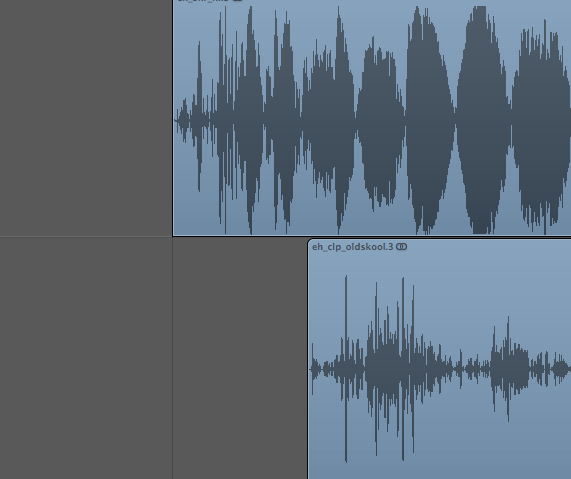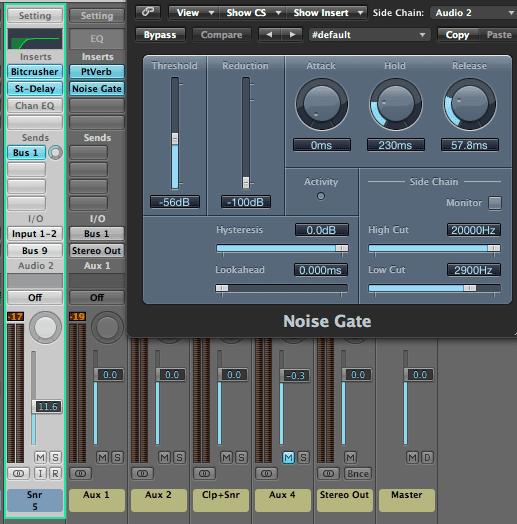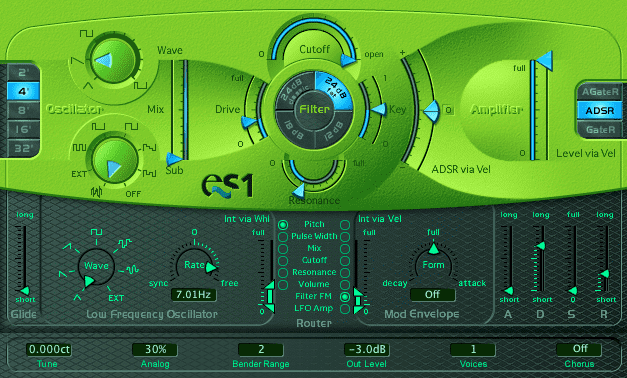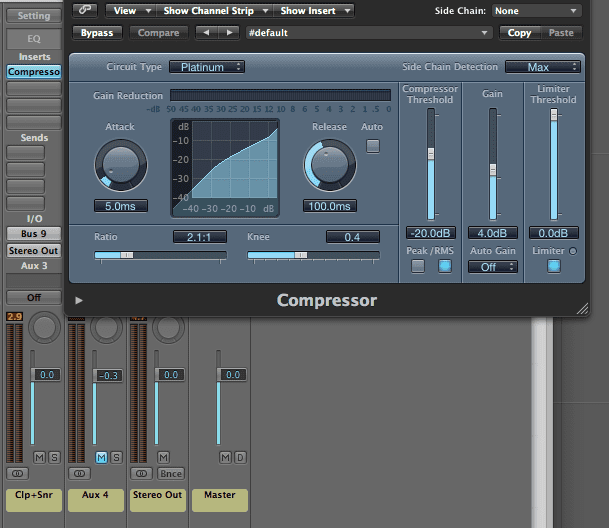Creating extra space between elements using reverb
Using varied reverb treatments allows you to create a mix with a better defined sense of space between individual elements. Instead of a straight ‘Hall’ or ‘Room’ reverb, a basic ‘Early Reflection’ program can work well. Early Reflections are a tightly clustered series of delays that normally come before the denser reverb tail. On their own they can provide some additional, yet uncluttered ambience.
Audio PlayerOf course there’s nothing stopping you adding a longer reverb, but you may want to automate this so that it only occurs on certain beats.
Audio PlayerThe ambient tweaking doesn’t need to stop there. Adding reverb to the snare hits can work well, but for a denser and cleaner approach consider turning to your DAWs noise gate and side-chain functionality. Set up the snare to send to a reverb as per normal, but follow it by a noise gate and set its side-chain to receive audio from the snare channel itself. By tweaking the gate’s threshold, hold and release settings it is possible to ‘shape’ the reverb with a swift (or even instant) decay.
Audio Player Audio PlayerTwo final layers
If you need to add some extra bite to your existing clap/snare layer then adding a short burst of white noise from a synth can help. In this case we’ve chosen an analogue-style synth plug-in and triggered it via MIDI notes programmed to occur at the same time as the existing snare hits.
Audio Player Audio PlayerFinally, we can add another clap to the equation. This time it’s a long clap sample that’s been reversed and placed to lead into the original clap on the last beat of the loop.
Audio PlayerLast Touches
Lastly, we’ll add a dose of compression to all the snare/clap variants (but not the kick) by routing them to their own buss, and processing as one. This tends to glue them all together in a more coherent way for the overall mix, and allows a degree of final shaping by adjusting the Attack and Release parameters.
Audio Player





11.21 AM
Awesome tip! Always wondered about pre-delay on rerveb. Quick question though: I’m using a VST drums (Slate) and I also have a rerveb buss that I send certain instruments through (including the snare) to give the illusion that they’re sharing the same space. So I wonder how I should apply this to the snare do I put it on the actual (dry) snare track? do I put it on the room mic’ in my drum VST, which is the natural space’ of the kit? do I then take the snare out of my rerveb buss? Any thoughts/suggestions?
11.37 AM
Hey,
There are no right answers here: different producers choose different ways.
Here are your options:
1. Insert a reverb plugin on the snare track. Tweak the wet/dry balance to get the amount of reverb you want.
2. Set up a reverb for the drum kit on a bus. This means you can send a little of any kit element to the same reverb. You can send some hi-hat signal, some tom signal – and some snare signal – to that same single bus. This would seem to be the best option for you as you state you want the illusion that the drum sounds are sharing the same space.
3. Send all drum parts to the same bus. Then on this group bus insert a reverb insert and tweak the wet/dry balance as in (1) above. You have considerably less control if you choose this method; each drum element in the group will be treated to the same amount of verb, which is rarely desirable.
re the ‘room mic’ signal: don’t confuse this. This is a specific signal included in VSTs (or captured live) that uses mics set up away from the kit (distant mics) to capture the natural ambient sound of the room. Some rooms that drums are recorded in have a fantastic ambient sound – and some of these are modelled in VSTs. It would be unusual to add additional reverb to this room channel, as it already *is* the reverb. (Although, as with all things audio, you can certainly give it a go and see what you come up with!)
Throwing this room signal into the mix then, I would suggest you simply set up a reverb sound on a bus, send as much snare signal (and any other drums’ signals) to that bus, and then you can mix the ‘room’ signal in to the balance you like. Of course one thing to note when doing so is that you will want to choose a reverb sound that complements to some extent the natural ambient sound of the room.
Hope this helps!
Dave @ Attack
12.36 PM
great piece. any recommendations for a similar stereo spread plug in for live? i use mda image on ads, but i dont think it would have the desired effect on clap/snare
thanks
12.36 PM
^ pads, not ads
02.10 PM
I think most songs these days have the worst snare sounds. So dry and weak. It usually sounds like they are recorded way in the background and with clap sounds, they sound unnatural. Why can’t more sound engineers make a snare drum sound like a snare drum. Similar to the song “One Headlight” by the Wall Flowers. That drum sounds great with no need for “Doctoring” the sound. We are living in a dark ages for sound recording IMO.
10.53 PM
@DWT, its clearly a matter of preference, i find that Wallflower snare boring. It has alot to do with how much the development of mix engineering integrated with the music to make the sounds we are use to. Everybody tried to get better, sometimes bigger, sounds and it left regular sounds sounding dull.
But i mean, look at Motown, Phil Spectre, The Beatles, etc, lots of distortion and processing. Its hard to find a plain snare with that resonant tone left in, it sounds like a pitch that varies, which can be out of tune with everything else, even when tuned.